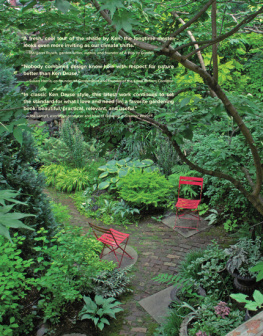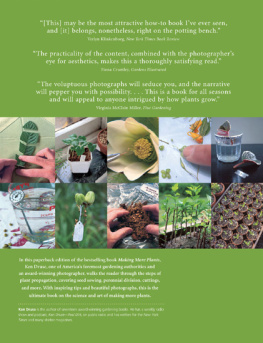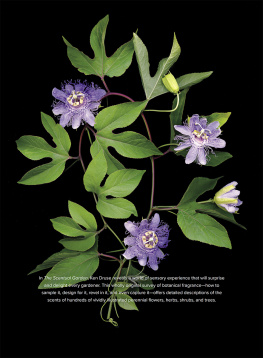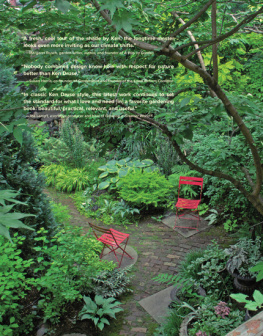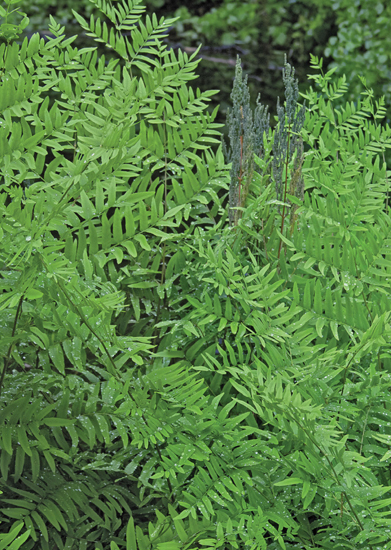




CONTENTS

Plants like white foamflower (Tiarella spp.) and tufts of grassy Carex morrowi var. temnolepis Silk Tassel grow beneath small-leafed rhododendrons in the Azalea Garden at the New York Botanical Garden.
NEW WORLD (DIS)ORDER: NATURES HARD TIMES
S hade is looking good to twenty-first-century gardeners. No one needs to be sold on the idea of finding shelter from the heat and sun anymore. As global average temperatures continue to rise, we have more reasons to seek a retreat in the shadows. Our gardens, and the world, are changing. In the early 1990s, when I first started writing and lecturing about shade gardening, people used to ask questions like How can I get rid of the shade on my property? Shade was seen as a curse. Nothing can grow in the shade was the oft-heard lament. People tried a couple of ferns or an astilbe, if that.
This was a time when the sunny English flower border captured the imagination of American gardeners with tints and shades of soft lavender, pink, and blue. In those days, far-north Britain was never too hot. Gardens there basked in bright daylight, with soft sun for long hours in the summer while the temperatures remained cool. In a given season, flowers would last many times longer there than in the United States, and one might come upon lilacs blooming with roses. In most of the United States, lilacs are long gone by the time the roses begin to flower.
In time, my audiences recognized that planting away from full sunlight under trees presented opportunities to grow some of the most exquisite and precious wildflowers that come from the worlds temperate forestsand incidentally, not from England, because the last ice age scraped away much of Great Britains flora. On the other hand, the southeastern United States is second only to China in the number of indigenous cold-hardy species.

Clockwise from top Plants of the worlds forests: Welsh poppy (Meconopsis cambrica) from the British Isles; a navelwort selection (Omphalodes cappadocica Cherry Ingram) originally from Turkey; variegated fairy bells in fruit (Disporum sessile Variegatum) from Japan.

Garden in the Woods, home of the New England Wild Flower Society, with understory trees like silverbell (Halesia tetraptera) and eastern redbud (Cercis canadensis).

The exquisite cold-loving white Japanese wood poppy (Glaucidium palmatum Album) grows well far north, at the Montreal Botanical Garden.
Fortunately, we are no longer talking about suffering with shade, or heaven forbid, getting rid of it by cutting down valuable trees. More people are trying to create shade instead. Who wouldnt want to find a spot in the summer garden that could be 10 to 20 degrees cooler than its counterpart in the sunny flower border? We are adding canopies and awnings, pergolas and gazebos, and planting more trees for now and for generations to come, not only to help create shady places but to also reduce our carbon footprints, since trees absorb and store carbon dioxide, or CO2, a primary greenhouse gas. (Wed have to plant a lot of trees to make up for our very big American feet. Its no secret that since the days of the Industrial Revolution, fossil fuels like coal, oil, and gasoline have been burned at ever-increasing rates, leading to a rise in atmospheric gases like CO2 and methane from industrial livestock production. Since the 1800s, CO2 has risen by 40 percent.)
Evidence of the effects is everywhere and is always apparent. Have you noticed that summer heat waves seem to happen nearly every year? Temperature swings are more extreme than in years past? That rainy days are less frequent, but often have much heavier downpours? That normal dry weeks in August may now stretch into months of drought? Even hurricanes act abnormally, for example, when Irene took a sharp turn to the west in 2011 or when, the following year, Sandy led to ocean surges and destruction in areas where such events were rare to unheard of.
The forecasts for a changing climate said we would begin to feel the effects of global warming by 2050. To longtime gardeners such as myself, though, it feels as if the changes hit around 2005, and they keep on coming. The projection for sea-level rise continues to be updated, and by 2100, climatologists predict the ocean will be 3 feet (1 m) higher than it is today, threatening coastlines around the world. Right now, hundreds of millions of people live in these places, but many will become uninhabitable, and some island nations will completely disappear.
How do we, as home gardeners, push ahead in the face of so much change?
A Call to Rethink
The garden of the future will be a shade garden. There are many reasons: fiscal, historical, environmentaland for the sake of our health and of the planets. In many ways, this is an older notion of landscapingits planting for generations to come. It wont happen overnight, though. For one thing, it means planting trees.
Since 1989, I have published several books with natural in the title. I used that word to mean naturalistica design style that was friendly to nature in its appearance, planting, and maintenance. Natural doesnt always mean native, or what would have lived on this continent in the years before humans arrived.
Picture the land thousands of years agocleared by lightning-sparked fire or Native Americans. Viable seeds in the ground would sprout once exposed to warmth and sunlight. In sunny open spaces, these seeds would most likely be meadow plants in the East and prairie plants in the Midwest. If there was enough rainfall, shrub and tree seeds would germinate as well, and in time, those woody plants would grow tall and cast shade on the meadow plants, which would gradually fade away. Eventually, a deciduous forest might take hold. This is the succession of plants that leads to forests and savannasplant communities dominated by trees. The leaves of the trees would filter sunlight. There would still be enough light in late winter and spring, however, for the woodland ephemerals such as trillium, bloodroot, and mayapple to thrive. These are the new (old) models for our gardens.

A meadow is a transitional plant community. This one is on the edge of a savanna in the Midwest. If there is enough moisture, and if it is not grazed, burned, or cleared for development, the meadow will become a woodland as tree and shrub seedlings slowly take hold.
Next page
